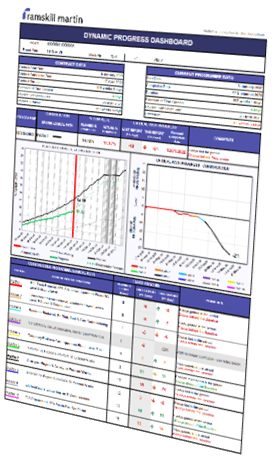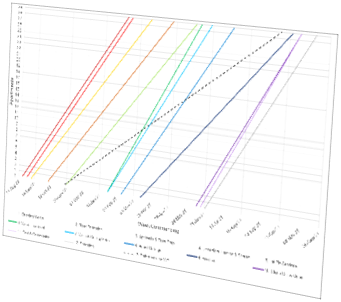Introduction
Planning is an important function in any construction organisation. It is often undervalued and the challenges underestimated. Everyone has heard the old adage “fail to plan – plan to fail”, but improvising is a risky business.
The purpose of Project Planning is to determine, develop and communicate the strategy of delivering the Project in a timely and orderly manner. An essential part of that delivery function is to be able to facilitate robust progress monitoring.
The purpose of progress monitoring is to measure current status in terms of time and commercial position, and to react to any deficiencies in current performance to improve and optimise future performance. The progress monitoring process also provides the raw data to be able to demonstrate the impact of change and/or delays on the Works.
A key skill of Planning, which is sometimes overlooked, is having the ability and facility to communicate both the plan and the progress data effectively. Having a plan is great, but if nobody can understand it then it is next to useless to the Project Team.

Progress Monitoring
The Project Programme is usually the means by which actual progress is monitored and reported against planned progress. In its most basic form, progress is normally presented by a simple “dropline” on the Gantt Chart. Whilst this may contain accurate progress data, what is presented can be a lot of information to digest, which the Project Team is unlikely to have the time or inclination to review.
Ramskill Martin’s (“RM”) Clients’ procedures usually dictate how progress reports should be carried out and in what form. Progress reports throughout the industry are usually generic, standard forms which present the overall Project position and a written description of the current key issues/activities at hand.
However, every Project and its associated Programme is different in terms of size, scope and complexity. Projects are changeable and every Project Team is different in terms of what they would like to see or know about when it comes to Project performance. So why restrict the way in which the information is presented?
Dynamic Progress Dashboard
RM utilises its Dynamic Progress Dashboard (“DPD”) to assist Employers/Developers, Contractors and Sub-Contractors with their progress reporting requirements. RM’s Team has developed this service over a number of years whilst assisting Clients on live projects. This service has a proven track record in assisting RM’s Clients with maintaining control of their Projects.
The DPD is a flexible and bespoke service for communicating the performance/position of a Project in a way that is focussed and meets the needs of the Project Team.
RM can assist its Clients in devising a realistic Programme (which is the crucial first step to implementing this system). Alternatively, RM can adopt its Client’s Programme. The key to successful implementation of the DPD is that the Programme is robust and reflects the planned intent and that it functions correctly when progress is recorded. Once a suitable Programme is in place, RM is then able to fully implement the DPD.
On large Projects there can be a vast amount of data and information available. The DPD can be tailored to provide you with the information required for your specific Project/Contract such as:
- “At a glance” assessment of your progress.
- Detailed reports to help you manage your Projects effectively.
- Information necessary to issue notices regarding progress and delay under JCT.
- A report which is compliant with the standard obligations under NEC3 or NEC4.
Whilst the DPD is bespoke to present key information which is pertinent to the needs of the Team, it is “dynamic” in that it can change to suit those needs as the Project advances.
RM’s Line of Balance Analysis (“LoB”) can be added to the DPD, or carried out on a standalone basis, and is specifically designed for high-rise or residential developments or indeed any Project which is highly repetitive (i.e. drainage infrastructure, utilities and communication installation) to:
- Provide an “at a glance” understanding of the rate of progress in a graph.
- See the projected completion of the Project, a floor or a trade.
- Model the impact of increased resources or working on more workfaces.
- See pinch points before they occur.
The DPD can record:
- The achieved progress along with trends.
- Critical path analysis.
- Forecasted completion date at the point of time the report is compiled.
- Key “logical path” analysis to identify “near-critical” elements of work.
- Assessment of the impact of events and ensure that the time obligations of Clients’ Contracts are complied with (including when notices should be issued and maintaining an up-to-date Programme).
Sometimes Project Teams can get “lost in the detail” or consumed by a single specific Project Event and lose sight of other developing issues which have the potential to become a greater threat to project performance. Advanced warning of these issues allows the Project Team time to address them before it becomes irrecoverable. The DPD provides all of this in an easy to understand, user-friendly manner.
The DPD is also a powerful management tool that provides information which enables RM’s Clients to make informed decisions with regards to the management of the Works on site, resource levels and the like and to decide where to focus their attention and efforts.

Implementation
Traditionally the progress monitoring on site is carried out manually, but there is an increase in the use of automated systems which can assess site progress. This is useful and time saving. The data created by these systems can be vast; in fact so vast that it becomes also meaningless. Information overload is a real risk with such systems.
Whichever method of progress data gathering is utilised, either manual or automated, as with any reporting, the output generated needs to be clear and understandable. No system can replace the value of a skilled and experienced Project Planner who can obtain, process and present the information in the most appropriate, meaningful manner.
The DPD service can be provided directly by RM’s experienced Planning Consultants by independently reviewing progress on site (“DPD(D)”) or RM can utilise progress data obtained and issued to RM by its Clients and then prepare remotely (“DPD(R)”).
RM has assisted its Clients by mixing the approach to provide a cost-effective service. The DPD(R) can be implemented whilst the Project is running on time with the DPD(D) being introduced if and when a Project becomes distressed or challenging.
-
Sheffield
The Annexe,
260 Ecclesall Road South,
Ecclesall,
Sheffield,
S11 9PSTel - 0114 230 1329
-
London
Adam House,
7-10 Adam Street,
London,
WC2N 6AATel – 020 7520 9295
-
Leeds
Suite 69,
4100 Park Approach,
Thorpe Park,
Leeds,
LS15 8GBTel - 0113 397 0358
-
Warrington
Suite 41,
Lakeview 600,
Lakeside Drive,
Centre Park Square,
Warrington,
WA1 1RWTel - 01925 984705
-
Manchester
3 Hardman Street,
Manchester,
M3 3HFTel - 0114 230 1329
-
Birmingham
Birmingham Business Park,
4200 Waterside Centre,
Solihull Parkway,
Birmingham,
B37 7YNTel - 0121 481 2381
-
Liverpool
Horton House,
Exchange Flags,
Liverpool,
L2 3PFTel - 07753 837149
